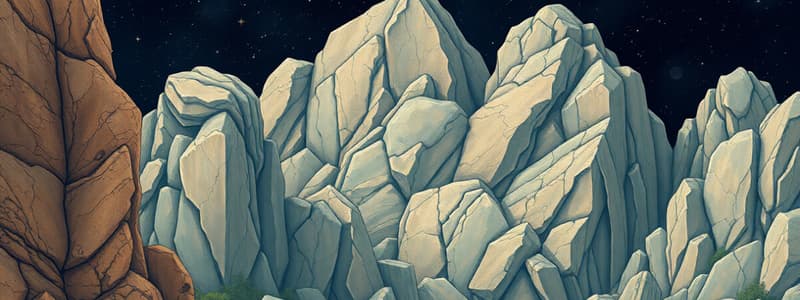Podcast
Questions and Answers
What is the primary process involved in the formation of igneous rocks?
What is the primary process involved in the formation of igneous rocks?
- Compaction of sediments
- Transformation under heat and pressure
- Cooling of magma or lava (correct)
- Formation from organic materials
Which of the following classifications is NOT a type of rock in the rock cycle?
Which of the following classifications is NOT a type of rock in the rock cycle?
- Organic (correct)
- Clastic
- Metamorphic
- Sedimentary
What is lithification in the context of sedimentary rock formation?
What is lithification in the context of sedimentary rock formation?
- The process of solidifying sediment (correct)
- The cooling of lava
- Pressure applied to magma
- The weathering of rocks
Which type of rock forms from the consolidation of particles from volcanic activity?
Which type of rock forms from the consolidation of particles from volcanic activity?
What differentiates intrusive igneous rocks from extrusive igneous rocks?
What differentiates intrusive igneous rocks from extrusive igneous rocks?
What are sediments in the context of sedimentary rock formation?
What are sediments in the context of sedimentary rock formation?
Which type of rock is formed directly from the cooling of lava on the earth's surface?
Which type of rock is formed directly from the cooling of lava on the earth's surface?
Which of the following is a characteristic of metamorphic rocks?
Which of the following is a characteristic of metamorphic rocks?
What is one of the main properties that characterizes minerals?
What is one of the main properties that characterizes minerals?
Which mineral is composed of only one element?
Which mineral is composed of only one element?
What does the term 'cleavage' in mineralogy refer to?
What does the term 'cleavage' in mineralogy refer to?
What property is measured using the Mohs Scale?
What property is measured using the Mohs Scale?
Which of the following accurately describes the term 'streak' in minerals?
Which of the following accurately describes the term 'streak' in minerals?
Which characteristic relates to the density of a mineral compared to water?
Which characteristic relates to the density of a mineral compared to water?
How is luster defined in the context of minerals?
How is luster defined in the context of minerals?
What causes the color of minerals?
What causes the color of minerals?
Which of the following would NOT be considered a physical property of minerals?
Which of the following would NOT be considered a physical property of minerals?
Using Archimedes' Principle to measure which property can indicate specific gravity?
Using Archimedes' Principle to measure which property can indicate specific gravity?
Study Notes
Rock Types
- Rocks are classified into three types, based on their formation: igneous, sedimentary, and metamorphic.
Igneous Rocks
- Igneous rocks are from solidified magma or lava.
- Magma cools in three ways:
- Below the surface - slow cooling magma (intrusive)
- Large crystals
- On the surface - fast cooling magma (extrusive)
- Small crystals
- Vesicular - air bubbles
- On the surface - consolidation of particles from volcanic activities
- Below the surface - slow cooling magma (intrusive)
- Examples of igneous rocks include Granite, Diorite, Cyanite, Basalt, and Andesite.
Sedimentary Rocks
- Sedimentary rocks are formed through deposition (accumulation) of materials.
- Materials are combinations of weathering and erosion, and organic materials.
- Solidified through Lithification.
- Sedimentary rocks are classified as:
- Clastic - compacted sediments
- Non-clastic - precipitates, bio matter, or evaporites
Minerals: Building Blocks of Rocks
- Minerals are the fundamental components of rocks.
- Minerals are composed of elements found in the periodic table.
- Abraham Werner is considered the "Father of Mineralogy" and was responsible for classifying minerals.
Defining Characteristics of Minerals
- Minerals are naturally occurring, inorganic, homogeneous solids.
- Minerals have a specific chemical composition represented by a chemical formula.
- Atoms within minerals are arranged in a specific crystalline pattern.
Minerals Composed of a Single Element
- Some minerals are made up of only one element:
- Gold
- Graphite
- Diamond
- Copper
Physical Properties of Minerals
- Luster: Describes how light reflects off the mineral's surface.
- High luster indicates a very reflective mineral.
- Luster can be described using terms like greasy, silky, metallic, earthy (suggestive of nature), or vitreous (glassy).
- Color: Caused by the absorption or lack of visible light. Color can vary greatly between different minerals.
- Streak: The color of a mineral's powder when rubbed against an unglazed surface. Useful for distinguishing between metallic and nonmetallic minerals.
- Hardness: A mineral's ability to resist scratching or abrasion.
- Measured using the Mohs Scale of Hardness (1 being the softest, 10 being the hardest).
- Cleavage: A mineral's tendency to break along planes of weakness.
- Defined breaks indicate good cleavage while less defined breaks indicate poor cleavage.
- Fracture: The way a mineral breaks when not along cleavage planes.
- Specific Gravity: A measure of the relative density of a mineral compared to water.
- Computed using the formula: specific gravity = mass of mineral / mass of equal volume of water.
- Specific Gravity can also be determined using Archimedes' Principle:
- A specimen weighs less in water than in air due to buoyancy.
- Specific gravity = weight of mineral in air / (weight in air - weight in water).
Studying That Suits You
Use AI to generate personalized quizzes and flashcards to suit your learning preferences.
Description
Test your knowledge on the three main types of rocks: igneous, sedimentary, and metamorphic. This quiz covers the formation, characteristics, and examples of each rock type. See how well you understand the processes involved in rock classification.




